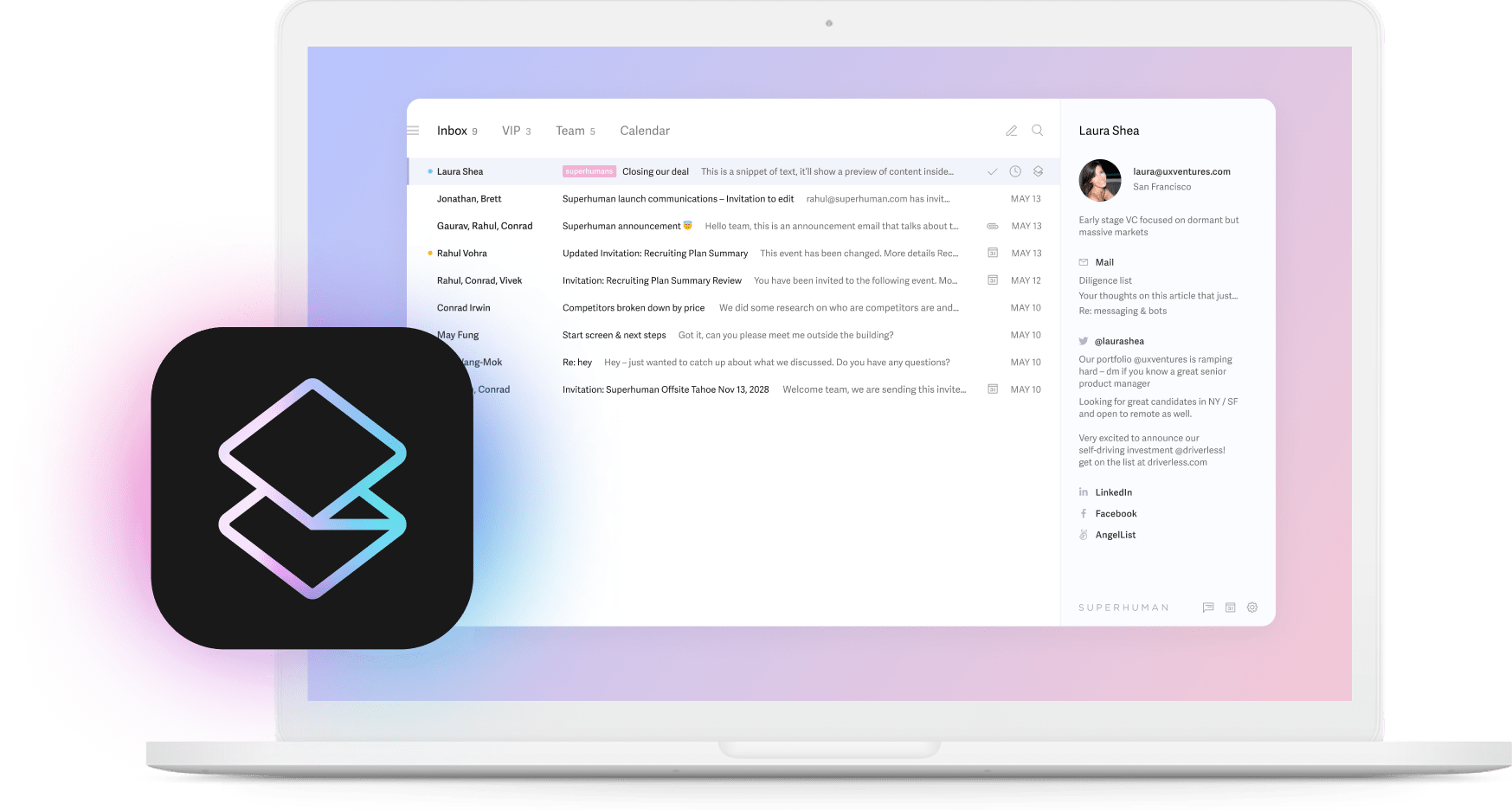
Email isn't going anywhere. Despite all the fancy new communication tools that pop up every year, email remains the backbone of how we get work done. It's our lifeline for talking to clients, documenting decisions, and keeping workflows moving. The problem? It's become a massive time-sink. The average professional now spends about 28% of their workday just managing their inbox. That's over two hours every day!
What was meant to make our lives easier has become a digital ball and chain. You know the feeling — you've cleared your inbox before lunch, only to find 25 new messages waiting by mid-afternoon. It's exhausting.
Here's the good news: forward-thinking companies are flipping the script by embracing AI email writers and AI-native email platforms. What was once a productivity drain is becoming a strategic advantage.
Superhuman and other AI-native platforms are transforming how we handle email at its core. These tools don't just help you process messages faster — they fundamentally change your relationship with email by handling routine tasks, surfacing what truly matters, and turning your communication into a competitive edge rather than a daily grind.
How AI email writers transform team performance
Ever notice how your inbox seems to be the place where momentum goes to die? You're not alone. Communication bottlenecks are often the hidden growth limiters in scaling organizations. While you're busy sorting through hundreds of messages, opportunities are slipping through the cracks and decisions are being delayed.
Critical communication challenges in high-growth companies
When companies hit the growth accelerator, the email situation goes from manageable to chaotic almost overnight. Here's what happens:
Missed opportunities: That important client email? It's buried under 50 others. That time-sensitive deal? It's gathering digital dust somewhere in your inbox.
Context switching: Your team is constantly ping-ponging between different conversations, losing productive time with each mental gear shift.
Inconsistent communication: Without a unified approach, customers and partners get wildly different experiences depending on who responds.
Information silos: Crucial knowledge stays locked in personal inboxes instead of benefiting the whole team.
These aren't just annoying productivity hiccups — they're system-wide drags that can stall an otherwise promising company's growth.
From individual productivity to team performance
This is where modern AI-native email platforms like Superhuman come into play. They're not just making individuals faster — they're transforming how entire teams communicate and collaborate through streamlined workflows:
AI-native prioritization: Think of it as your personal email bouncer, making sure VIPs (Very Important Emails) skip the line. No more missing the message from your biggest client because it was sandwiched between newsletter subscriptions.
Automated responses: Your AI email writer becomes your personal ghostwriter, drafting replies that sound like you — while you focus on work that actually requires your unique skills and perspective.
Team alignment: Everyone stays on message with shared templates & writing styles. Your customers get the same quality experience whether they're talking to sales, support, or the CEO.
Knowledge sharing: Those brilliant responses your colleague crafted last month? AI tools surface them right when you need them, breaking down those frustrating information silos.
The real magic happens when you work smarter by applying these productivity boosts across your entire organization. Suddenly, everyone's spending less time managing their inbox and more time driving your business forward.
Try SuperhumanMeasurable business impact
Let's talk real numbers, because this isn't just about feeling less overwhelmed (though that's a nice bonus).
Professionals using AI support write 59% more business communications per hour than their non-AI-equipped peers. Think about that — it's like adding 2-3 extra hours to everyone's workday without actually working longer.
These aren't vanity metrics either. They translate directly to business outcomes that executives and investors care about: faster response times to customers, higher conversion rates on sales outreach, and better overall customer experience. In AI email marketing, personalized messages generate six times higher transaction rates compared to generic blasts.
For growing companies where every minute counts, these efficiency gains can be the difference between hitting your ambitious targets or stalling out. Superhuman users save an average of 4 hours weekly per person — that's half a workday back in your calendar. Teams respond 12 hours faster and handle twice as many messages without breaking a sweat. Imagine what your team could accomplish with that extra time and mental bandwidth.
Key capabilities of modern AI email writers
AI-native email solutions are changing how teams communicate, collaborate, and drive business results. These tools go way beyond simple grammar checking or templates.
Superhuman: The AI email writer transforming productivity
Superhuman leads the AI email revolution with features designed to enhance email management and eliminate inbox overload:
Auto Labels automatically classify incoming messages, helping you respond faster to what matters most.
Auto Drafts help you follow up on time, every time.
Ask AI gets you rapid answers without remembering senders or guessing keywords.
Split Inbox automatically triages incoming email.
Team Comments & Shared Threads help teams collaborate faster than ever before.
What makes Superhuman stand out is how it weaves AI throughout the entire email workflow rather than treating it as an add-on. Superhuman automatically archives hundreds of email every week, making your inbox feel 10x lighter.
Comparative analysis of leading solutions
While Superhuman offers a comprehensive approach, other specialized solutions excel in specific areas:
Help Scout focuses on customer support, ensuring team-wide consistency and enabling support agents to handle 13.8% more inquiries per hour.
Lavender specializes in sales outreach, scoring email drafts based on response likelihood and providing targeted coaching.
Grammarly Business emphasizes team-wide writing standards, ensuring consistent tone across all customer-facing communications.
Research shows professionals using AI communication tools write 59% more business communications per hour, highlighting the substantial productivity gains these solutions enable.
Evaluation framework for decision-makers
When evaluating AI email solutions for your organization, consider these key criteria:
Team alignment capabilities: How effectively does the solution maintain consistent voice across different team members?
Revenue impact potential: Will the solution directly influence customer acquisition or retention through improved communication?
Integration with existing workflows: Does the solution work within your current tech stack without creating friction?
By systematically evaluating AI email solutions against these criteria, you can select the platform that best addresses your specific communication challenges. Superhuman saves teams 15 million hours every year, making it the most productive email app ever made.
Industry-specific applications & use cases
AI email writing is transforming business communication across diverse sectors, with each industry finding unique ways to use this technology for their specific challenges.
For high-growth tech companies
Rapidly scaling tech companies struggle to maintain consistent communication as they grow. AI email writers help by:
Creating standardized onboarding sequences that maintain quality as teams expand.
Ensuring leadership messaging remains clear and consistent across growing departments.
Automating routine updates, allowing teams to focus on building products rather than crafting status email.
For example, managing remote teams can be challenging, but remote tech teams can use AI email writers to draft and standardize internal status updates and meeting summaries. This ensures stakeholders receive clear, uniform recaps regardless of who sends them, which is crucial for maintaining alignment during rapid growth.
For financial services (VC & PE)
In the high-stakes world of venture capital and private equity, timely and precise communication can determine whether deals succeed or fail. Financial services firms use AI email writers to:
Create personalized investor updates that maintain relationships while saving time.
Craft time-sensitive deal communications with appropriate urgency and detail.
Ensure compliance requirements are met in all external communications.
The impact is most notable in client relationship management, where partners spend less time drafting routine updates and more time on strategic decisions.
For professional service providers
Consultants, lawyers, accountants, and other professional service providers juggle high client expectations with limited time. AI email writers help by:
Generating consistent client communications that maintain service standards.
Creating professional follow-ups after meetings or consultations.
Maintaining appropriate tone and formality across all client interactions.
Professional service firms using AI email tools report a 40% improvement in client response rates, largely attributed to more timely and relevant communication.
For sales & revenue teams
Sales professionals face constant pressure to personalize outreach while maintaining high volume. AI tools for sales transform their workflow by:
Analyzing prospect data to suggest personalized opening lines and pain points.
Generating follow-up sequences tailored to specific prospect behaviors.
Creating proposal email that highlight relevant case studies and benefits.
Leveraging email snippets for sales teams and utilizing the best sales productivity tools can further streamline communication.
By combining AI email writers with proven sales promotion techniques, teams can significantly boost their conversion rates.
One sales team using AI tools like Lavender to create personalized cold email achieved a 26% higher open rate and improved cold call-to-meeting conversion rates. With Superhuman, you can fly through your inbox and save 4 hours per week every week.
Implementation strategies for maximum ROI
Implementing AI email solutions effectively requires more than just adopting new software. To maximize your return on investment, you need to consider integration points, change management, and performance measurement.
Integration with critical business systems
The real power of AI email tools emerges when they're connected with your existing business ecosystem. Most modern AI email solutions integrate seamlessly with CRM systems, project management tools, and marketing automation platforms, allowing you to implement effective email marketing strategies.
Integration creates a multiplier effect on productivity. For example, when your AI email tool can access customer data from your CRM, it can generate more relevant messages without your team having to manually search for that information.
Team adoption & change management
Even the most powerful AI tool delivers zero ROI if your team doesn't use it effectively. These approaches work particularly well:
Identify power users: Start with tech-savvy team members who can provide feedback and become internal champions.
Implement in phases: Begin with a specific department or use case before expanding.
Create clear guidelines: Develop standards for when and how to use AI tools versus when human oversight is necessary.
Also, ensuring team members have optimized their remote work setups, such as learning how to optimize your Zoom setup, can enhance overall productivity when implementing new tools.
When implementing AI email tools, one sales team achieved a 26% higher open rate by first training a small group of reps who then helped spread adoption across the department.
Establishing performance metrics
You can't improve what you don't measure. Before implementation, establish clear baselines for time metrics, quality metrics, and business impact metrics.
With these baselines established, you can accurately track improvements. For example, businesses using AI-native email tools report up to a 10x increase in email generation speed while maintaining or improving quality.
By focusing on integration, thoughtful adoption, and careful measurement, you'll ensure your AI email implementation delivers substantial returns. Make email feel good again with Superhuman.
Security, compliance, & enterprise considerations
When implementing AI email tools in an enterprise environment, security and compliance become critical factors for decision-makers. These sophisticated tools handle vast amounts of sensitive business communications, making proper safeguards essential.
Protecting sensitive business communications
AI email tools require access to your communication data to function effectively, creating potential vulnerabilities. Before implementation, verify that potential solutions offer:
- End-to-end encryption for all data in transit and at rest.
- Clear data retention policies that align with your business requirements.
- Transparent information on how your data is used to train AI models.
Additionally, reviewing the solution's privacy settings is essential to ensure data is handled appropriately.
Many vendors now provide dedicated enterprise instances with isolated data processing to prevent cross-contamination between clients.
Regulatory compliance framework
Enterprise AI email solutions must adhere to multiple compliance standards, particularly for companies operating across borders or in regulated industries. Essential compliance considerations include:
- GDPR compliance for handling European user data, including the right to be forgotten.
- CCPA alignment for California consumers.
- Industry-specific regulations like HIPAA for healthcare, FINRA for financial services, or FedRAMP for government contractors.
Decision-makers should request detailed documentation about how vendors maintain compliance with these frameworks. Additionally, reviewing the vendor's terms, including any arbitration agreement, is crucial for understanding legal obligations. The most enterprise-ready solutions provide compliance certificates and regular audit reports.
Enterprise-grade security requirements
Beyond basic security measures, enterprise implementations require additional safeguards:
- Role-based access controls to restrict who can access specific communications.
- Multi-factor authentication for all users.
- Detailed audit logging of system access and actions.
- Integration with enterprise identity management systems like Okta or Azure AD.
Look for vendors with SOC 2 Type II certification, which validates their security, availability, and confidentiality controls. Superhuman is what email should have been all along.
Emerging capabilities in AI email writers
The field of AI email management is evolving beyond simple automation toward sophisticated intelligence that promises to transform how high-performance teams communicate.
Advanced communication intelligence
Future AI email systems will develop a deeper understanding of business context. Rather than simply processing keywords, these systems will comprehend complex organizational structures, project histories, and team dynamics.
The next generation of AI will also better interpret emotional nuances in written communication. By analyzing subtle language patterns, these systems will recognize urgency, enthusiasm, or concern, then adapt their response suggestions accordingly.
Cross-platform team alignment
As teams increasingly use multiple channels for communication, future AI systems will excel at creating coherence across these fragmented information sources. AI will track conversations that start in email and continue in Slack, then resurface relevant context when needed.
These cross-platform capabilities will significantly enhance team alignment by ensuring everyone has access to the same information. For high-growth teams managing rapid change, this seamless information flow will eliminate knowledge silos that typically slow decision-making.
Predictive response optimization
Beyond simply suggesting replies, next-generation AI will predict likely outcomes of different communication approaches. Before you send an important email, the AI might suggest: "Based on past interactions with this contact, a more concise message with bullet points has a 40% higher response rate."
Studies show that teams supported by predictive AI tools can handle 13.8% more inquiries per hour while achieving four times faster skill acquisition compared to non-AI agents.
Your inbox is waiting for an upgrade — with emerging technologies continually improving the email experience. Make email feel good again with Superhuman.
Implementation roadmap for high-growth companies
As high-growth companies scale rapidly, communication often becomes a bottleneck that limits productivity and decision-making speed. Implementing AI email tools requires a strategic approach to maximize ROI.
Assessing communication bottlenecks
Begin with a thorough assessment of your current communication landscape:
Conduct a communication audit: Analyze email volume, response times, and time spent on email-related tasks across departments.
Calculate opportunity costs: Quantify the hours your teams spend on routine email tasks that could be automated.
Identify pattern inefficiencies: Look for repetitive email types that consume disproportionate time.
When calculating opportunity costs, consider that AI-supported professionals write 59% more business communications per hour compared to those without AI support.
Phased deployment strategy
Implement a structured rollout approach:
Pilot phase (2-4 weeks): Select 1-2 teams based on high-impact criteria. Establish baseline metrics before implementation. Provide intensive training and gather daily feedback.
Evaluation phase (1-2 weeks): Analyze usage patterns and adoption rates. Identify needed adjustments to workflows or training.
Expansion phase (1-3 months): Roll out to additional departments with refined implementation approach. Create internal champions from successful pilot teams.
AI email tools have shown to significantly reduce employee workload by automating responses, allowing your team to focus on higher-value tasks that drive growth.
Measuring business impact
Track key metrics to quantify the value of your implementation:
Time savings: Measure reduction in time spent on email drafting and management. Track average response times before and after implementation.
Decision velocity: Monitor the time between initial communication and final decisions. Track project timelines pre- and post-implementation.
Quality improvements: Track customer satisfaction scores for teams using AI tools. Evaluate message quality improvements (studies show an average quality rating increase from 3.8 to 4.5 out of 7 when using AI tools).
By implementing this structured approach, high-growth companies can rapidly overcome communication bottlenecks while ensuring consistent messaging that scales with the organization.
With AI-native tools like Superhuman, teams can finally take control of their inboxes and get back hours each week. These platforms go beyond speed. They improve focus, reduce friction, and help your team communicate with clarity and consistency.
The future of email is intelligent, intuitive, and deeply connected to how modern teams work. Whether you're scaling a startup or managing client relationships, AI email tools help you move with speed and clarity. It’s not just about saving time. It’s about making your communication sharper, your workflows smoother, and your business more effective.






